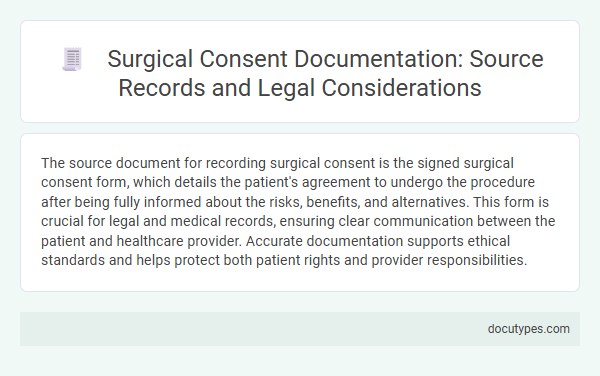The source document for recording surgical consent is the signed surgical consent form, which details the patient's agreement to undergo the procedure after being fully informed about the risks, benefits, and alternatives. This form is crucial for legal and medical records, ensuring clear communication between the patient and healthcare provider. Accurate documentation supports ethical standards and helps protect both patient rights and provider responsibilities.
Introduction to Surgical Consent Documentation
Surgical consent documentation serves as a crucial legal and ethical record in medical procedures. It ensures that patients are fully informed about the surgery, risks, benefits, and alternatives before agreeing to the intervention.
The primary source document for recording surgical consent is the signed consent form. This form is completed and signed by the patient or their legal representative, confirming their understanding and approval of the surgical procedure.
Definition and Importance of Source Records
The source document for recording surgical consent is the original medical record that includes the patient's signed consent form. This document serves as the definitive legal and medical evidence of the patient's informed agreement to undergo surgery.
- Definition - The source document is the primary record capturing the patient's consent details before any surgical procedure.
- Importance - It ensures clear communication between the healthcare provider and patient regarding the nature and risks of the surgery.
- Compliance - This record is critical for medico-legal protection and audit purposes, affirming that the patient was properly informed.
Accurate documentation in the source record is essential to uphold patient rights and support quality medical care.
Legal Framework Governing Surgical Consent
The source document for recording surgical consent is the signed surgical consent form, which serves as the primary legal record. Understanding the legal framework governing surgical consent is crucial to ensure that You have authorized the procedure knowingly and voluntarily.
- Informed Consent Requirement - Legal standards mandate that patients receive comprehensive information about the risks, benefits, and alternatives before surgery.
- Documentation Standards - The surgical consent form must clearly document the patient's agreement and understanding to protect both the patient and healthcare provider legally.
- Regulatory Compliance - Hospitals and surgical centers adhere to specific laws and institutional policies that govern the proper obtaining and recording of surgical consent.
Key Elements of a Valid Surgical Consent Form
| Source Document for Recording Surgical Consent | |
|---|---|
| The primary source document for recording surgical consent is the Surgical Consent Form. This official medical document captures a patient's authorization for a surgical procedure after being informed of the risks, benefits, and alternatives. | |
| Key Elements of a Valid Surgical Consent Form | Description |
| Patient Identification | Full name, date of birth, and medical record number to ensure accurate patient association. |
| Procedure Description | Clear, detailed explanation of the surgical procedure to be performed. |
| Risks and Benefits | A summary of common risks and potential benefits related to the surgery. |
| Alternatives | Presentation of viable alternative treatments or procedures. |
| Voluntary Consent | Statement confirming that consent is given voluntarily without coercion. |
| Signature and Date | Signature of the patient or authorized representative, dated to verify timing of consent. |
| Witness Signature | Signature of a witness or healthcare provider to validate the consent process. |
| Patient Questions Addressed | Notes or confirmations that all questions raised by you were answered satisfactorily. |
Patient Capacity and Informed Decision-Making
The source document for recording surgical consent is the signed surgical consent form, which serves as legal and medical evidence of your agreement to the procedure. Assessing patient capacity is crucial, ensuring that the individual understands the nature, risks, and benefits of the surgery before providing consent. Informed decision-making involves clear communication between healthcare providers and patients, enabling patients to make knowledgeable choices about their treatment options.
Documentation Standards and Best Practices
The source document for recording surgical consent is the official surgical consent form signed by the patient or their legal representative. This document serves as the primary legal record confirming that informed consent was obtained prior to the procedure.
Documentation standards require that the consent form includes detailed information about the procedure, risks, benefits, and alternatives. Best practices emphasize clear legibility, accurate dating, and consistent storage within the patient's medical record to ensure compliance and patient safety.
Electronic vs. Paper Records: Implications in Consent
What is the source document for recording surgical consent in medical practice? Surgical consent can be documented either through electronic health records (EHR) or traditional paper forms. Your choice between electronic and paper records impacts accuracy, accessibility, and legal compliance in consent documentation.
Common Legal Challenges in Consent Documentation
The source document for recording surgical consent is the signed consent form completed by the patient before the procedure. This document serves as the primary legal record confirming that the patient has been informed about the risks, benefits, and alternatives of the surgery.
Common legal challenges in consent documentation include inadequate explanation of procedure risks, failure to document patient understanding, and missing signatures. Incomplete or unclear consent forms can lead to disputes over whether informed consent was properly obtained. Healthcare providers must ensure thorough communication and accurate record-keeping to minimize litigation risks related to surgical consent.
Risk Management and Minimizing Litigation
The source document for recording surgical consent is the signed surgical consent form, which legally documents the patient's acknowledgment and understanding of the procedure, associated risks, and alternatives. This form serves as a critical risk management tool by ensuring clear communication between the surgical team and patient, reducing misunderstandings that could lead to complications or disputes. Properly completed and stored consent forms minimize litigation by providing concrete evidence of informed consent in case of legal scrutiny.
What Is the Source Document for Recording Surgical Consent? Infographic

